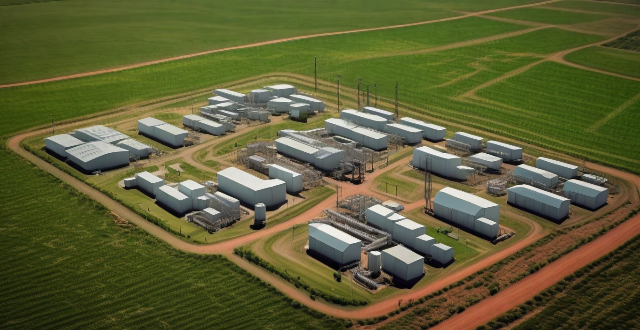Energy Potential

What is the future potential of compressed air energy storage (CAES) ?
Compressed air energy storage (CAES) is a promising technology that has the potential to revolutionize the way we store and use energy. Key points about its future potential include increased efficiency and scalability, low cost and long lifespan, environmental benefits, and integration with other technologies. CAES systems can be scaled up or down depending on the amount of energy storage required and offer good value for money over their lifetime. They also have a long lifespan, typically lasting 20 years or more with proper maintenance. Additionally, CAES systems can help reduce carbon emissions by using renewable energy sources such as wind and solar. Finally, they can stabilize the grid during peak demand periods and be combined with other forms of energy storage to create hybrid systems that offer even greater flexibility and efficiency.

What is the current state of fusion power research and its potential as an ultimate renewable energy source ?
Fusion power research aims to harness energy from fusing atomic nuclei, similar to the sun's process. Key developments include the ITER project, breakthroughs in magnetic confinement fusion, and advances in inertial confinement fusion. Challenges include technical hurdles, economic viability, and safety concerns. Fusion power has potential as an ultimate renewable energy source due to its unlimited and clean energy production, minimal environmental impact, and long-term sustainability.

Are there any drawbacks to using energy-efficient lighting systems ?
Energy-efficient lighting systems offer reduced energy consumption and cost savings, but come with potential drawbacks such as higher upfront costs, compatibility issues, color quality concerns, maintenance and disposal challenges, and potential health risks. It's important to weigh the pros and cons carefully before making a final choice.

What is the potential of algae-based biofuels in providing a renewable energy alternative ?
Algae-based biofuels offer a renewable energy alternative with high productivity, low environmental impact, and potential to reduce greenhouse gas emissions. They can be grown on non-arable land, require no herbicides or pesticides, and absorb CO2 during photosynthesis. Technological advancements in genetically modified strains and cultivation techniques are improving growth rates and oil yields. However, challenges related to scalability, economic viability, and supply chain reliability must be addressed for widespread adoption as a sustainable energy solution.

What are the potential health benefits of an energy transition ?
The energy transition from fossil fuels to renewable sources can significantly improve public health by reducing air pollution, mitigating climate change effects, creating economic opportunities in clean energy sectors, and promoting active lifestyles. This shift benefits respiratory and cardiovascular health and can lead to better access to healthcare services. Policies supporting the energy transition should consider both environmental and health objectives for a sustainable and healthier future.

What are some potential challenges and drawbacks of distributed energy systems ?
Distributed energy systems (DES) offer benefits such as increased energy independence and reduced carbon emissions, but they also present several challenges. These include interconnection issues with the power grid, reliability concerns due to weather dependency and storage limitations, high upfront costs, complex permitting processes, operation and maintenance expenses, environmental impacts from resource extraction and waste management, potential job losses in traditional energy sectors, and shifts in energy market dynamics. Addressing these challenges requires technological innovation, policy development, and consumer education.

What are the potential returns on investment for clean energy projects ?
Investing in clean energy projects offers potential financial, environmental, and social returns. Factors such as capital appreciation, dividends, tax credits, carbon emission reductions, air quality improvements, job creation, and energy security contribute to the overall benefits of these investments. As the global transition towards a low-carbon economy progresses, investing in clean energy projects presents a wise and sustainable option for investors seeking both positive impact and financial gains.

How does wind energy affect the environment ?
Wind energy is a renewable source of power that has become increasingly popular as an alternative to fossil fuels. However, like any form of energy production, it does have some environmental impacts. The positive effects of wind energy on the environment include a reduction in greenhouse gas emissions, conservation of natural resources such as water and no need for fuel. Wind farms can coexist with agricultural activities and modern turbine designs can help minimize impacts on local wildlife. However, there are also potential negative effects on the environment. These include visual and noise pollution, as well as potential impacts on wildlife such as bird and bat collisions and habitat disruption. The presence of large structures like wind turbines can also alter local wind patterns and potentially affect microclimates. Overall, while wind energy offers significant benefits in terms of reducing greenhouse gas emissions and conserving natural resources, it is not without its challenges regarding visual and noise pollution, as well as potential impacts on wildlife. Careful planning and technological advancements can help mitigate these negative effects, making wind energy an increasingly viable option for a sustainable future.

What are the potential drawbacks or challenges of implementing blockchain ?
The article discusses several potential issues with blockchain technology, including lack of regulation, scalability concerns, security vulnerabilities, and interoperability challenges. It highlights the need for clear legal and compliance guidelines, tax treatment standards, improved transaction speeds, reduced energy consumption, ongoing security measures, thorough smart contract testing, and increased standardization across different blockchains. Overall, while blockchain offers many potential benefits, these challenges must be addressed in order for the technology to reach its full potential.

What are some potential solutions to combat climate change ?
Potential Solutions to Combat Climate Change

What are the potential benefits and drawbacks of nuclear power in terms of climate change and energy security ?
Potential Benefits of Nuclear Power: - Low carbon emissions during operation, contributing to climate change mitigation. - High energy density of uranium enhances energy security by reducing reliance on imported fuels. - Ability to provide stable baseload power ensures reliability and energy security. Potential Drawbacks of Nuclear Power: - Significant GHG emissions from mining, refining uranium, plant construction, and decommissioning. - Long-lived radioactive waste poses challenges for climate change mitigation and environmental safety. - Risk of meltdowns and nuclear proliferation undermines energy security.

What are the potential economic impacts of increased climate variability ?
This article discusses the potential economic impacts of increased climate variability on various sectors, including agriculture, water resources, energy, and tourism. It highlights how changes in weather patterns can lead to reduced crop yields, increased input costs, loss of biodiversity, droughts and floods, reduced water availability, higher demand for cooling systems, altered tourist destinations, and extreme weather events. The article emphasizes the importance of recognizing these potential impacts and taking steps to mitigate them through sustainable practices and adaptation strategies to build a more resilient economy that can withstand the challenges posed by a changing climate.

What are the potential benefits of establishing a lunar base ?
**Heading: Potential Benefits of Establishing a Lunar Base** - **Advancements in Science and Technology:** Research opportunities in various fields, technological advancements in engineering and manufacturing, and testing new equipment for future missions. - **Economic Opportunities:** Job creation across industries, need for support staff, and the emergence of a new industry focused on lunar base operations. - **Energy Production:** Ideal location for solar power generation, potential for energy export to Earth, and development of efficient solar technology with Earth applications. - **Space Exploration and Travel:** Stepping stone for deeper space exploration, testing new propulsion systems and spacecraft designs, and paving the way for human settlements on other planets or moons. - **International Cooperation and Diplomacy:** Requirement for international collaboration, fostering diplomatic relations, promoting peaceful cooperation among nations, and encouraging global cooperation in addressing shared challenges.

What are the potential consequences of not reducing greenhouse gas emissions ?
Not reducing greenhouse gas emissions can have severe consequences for our planet, including climate change, ecosystem impacts, human health and well-being, economic impacts, and social and political impacts. Rising temperatures, extreme weather events, sea level rise, habitat loss, species extinction, food web disruptions, poor air quality, water scarcity, loss of livelihoods, agricultural productivity, infrastructure damage, energy demand, migration, resource wars, and political instability are all potential consequences of not taking action to reduce greenhouse gas emissions. It is crucial that we take action to mitigate these potential consequences and protect our planet for future generations.

How does clean energy investment compare to traditional energy investment ?
Investing in energy sources is crucial for the development and growth of any economy. However, the choice between clean energy investment and traditional energy investment has become a significant topic of discussion in recent years. This comparison will explore the differences between these two types of investments, focusing on their costs, benefits, and potential impacts on the environment and society.

What is the potential for wind energy in my region ?
The potential for wind energy in a region depends on geographical features, wind speed and consistency, governmental policies, environmental and social considerations, and infrastructure accessibility. Coastal areas, plateaus, mountain passes, and open plains typically have better wind energy potential due to consistent wind patterns and less obstruction. High average wind speeds and consistency are crucial for effective power generation. Governmental policies such as Renewable Portfolio Standards, feed-in tariffs, and tax credits can encourage wind energy development. Environmental and social considerations include wildlife impact, visual and noise pollution, and local economy effects. Infrastructure and accessibility to power grids and transportation networks are also important factors.

What is the potential for clean energy technology to transform transportation ?
Clean energy technology has the potential to revolutionize transportation by reducing emissions, improving air quality, and enhancing energy security. This can be achieved through electric vehicles (EVs), hydrogen fuel cells, renewable energy sources, and smart grid technologies. EVs offer reduced emissions, energy efficiency, lower operating costs, and quiet operation. Advances in battery technology have increased range and reduced charging times for EVs. Charging infrastructure is being developed to support the growing number of EVs. Hydrogen fuel cell vehicles provide long-range travel and rapid refueling while utilizing renewable energy sources. However, they face challenges such as high production costs and limited infrastructure. Renewable energy sources like solar, wind, and hydropower can provide clean electricity for EVs and hydrogen production. Smart grid technologies enable efficient management of electricity demand and supply, supporting the integration of renewable energy into the power grid. Overall, clean energy technology has the potential to significantly transform the transportation sector towards sustainability.

How is renewable energy affecting the traditional energy market ?
Renewable energy sources are having a significant impact on the traditional energy market, affecting pricing, market share, job creation, and environmental concerns. The increased efficiency and reduced installation costs of renewable technologies have made them more competitive with traditional energy sources, leading to declining electricity prices overall. Additionally, the growing demand for renewable energy sources has led to an increase in their market share, particularly for solar and wind power. The transition to renewable energy is also creating new job opportunities across various sectors of the economy, while addressing environmental concerns associated with fossil fuel consumption.

How does a home energy audit help in saving on electricity ?
A home energy audit helps identify inefficiencies and suggests upgrades, leading to electricity savings. It includes checks on insulation, air leakage, ductwork, appliance efficiency, and lighting systems. It also promotes behavioral changes and renewable energy options, providing a prioritized plan for improvements along with information on financial incentives.

What are the main sources of sustainable energy ?
The text discusses the various main sources of sustainable energy, including solar energy, wind energy, hydropower, geothermal energy, bioenergy, tidal and wave energy, and hydrogen energy. It also highlights the importance of adopting sustainable energy for environmental impact, economic benefits, energy security, and health considerations. The transition to sustainable energy requires investment, policy support, and technological innovation.

What are the economic benefits of investing in energy-efficient industrial equipment ?
Investing in energy-efficient industrial equipment can lead to reduced energy costs, increased production efficiency, potential tax incentives and grants, enhanced competitiveness, improved environmental sustainability, and greater long-term asset value. These benefits make such investments financially prudent and strategically sound for businesses looking to remain competitive and responsible in today's market.

What impact do energy storage solutions have on the economics of renewable energy ?
Energy storage solutions significantly impact renewable energy economics by addressing variability and unpredictability. They enhance grid stability, reduce costs, and increase efficiency, thus making renewable energy more viable. With ongoing technological advancements, energy storage will continue to play a crucial role in integrating renewable energy into power grids and achieving global decarbonization goals.

What are the potential benefits of carbon capture technology for the environment ?
Carbon capture technology can help reduce greenhouse gas emissions, improve air quality, encourage economic growth, and enhance ecosystem health. It has the potential to mitigate climate change, meet emission reduction targets, enhance energy security, reduce pollutants, protect human health, create jobs, stimulate innovation, promote clean energy, protect biodiversity, preserve natural resources, and restore degraded landscapes. Investing in carbon capture technology may prove to be crucial for creating a more sustainable future.

Can renewable energy sources effectively replace fossil fuels ?
- Renewable energy sources are sustainable and produce fewer emissions than fossil fuels. - Intermittency, storage, and cost are challenges to the adoption of renewable energy. - Grid integration, energy storage advancements, and government policies can help overcome these challenges.

How does wind energy compare to solar energy ?
Wind energy and solar energy are both renewable sources of energy that have gained popularity in recent years. Wind turbines can generate electricity with high efficiency and low maintenance cost, while solar panels have a low initial cost and long lifespan. However, wind turbines can create noise pollution and have limited availability, while solar panels rely on sunlight and require a large amount of land. Both sources have their advantages and disadvantages, making them suitable for different applications.

What are the potential benefits and drawbacks of remote work in the future ?
The potential benefits of remote work in the future include flexibility and enhanced work-life balance, productivity gains, cost savings, access to global talent, and a positive environmental impact. However, there are also potential drawbacks such as isolation and lack of social interaction, communication challenges, work-life boundary blurring, management and supervision issues, and security risks. It is important for individuals and organizations to consider these factors when deciding on the feasibility and implementation of remote work arrangements.

What are the potential risks and challenges associated with implementing CSR initiatives ?
Implementing Corporate Social Responsibility (CSR) initiatives can bring benefits to a company, but also comes with potential risks and challenges. These include lack of clear goals and objectives, limited resources, stakeholder pressure, legal and regulatory issues, difficulty measuring impact, and potential backlash from stakeholders. Companies need to carefully consider these issues before committing to CSR efforts, and should work to mitigate any potential risks through careful planning and execution.

How does geothermal energy work and is it a viable alternative energy source ?
Geothermal energy is a renewable and sustainable source of energy that harnesses the natural heat from within the Earth's crust. This energy is obtained by drilling wells into the Earth's crust, where the heat is transferred to water or another fluid in a heat exchanger. The heated fluid then spins a turbine to generate electricity. There are three main types of geothermal power plants: dry steam, flash steam, and binary cycle. While geothermal energy has many benefits, including being renewable, cost-effective, and abundant in certain areas, it also comes with high upfront costs and location limitations. Additionally, there are environmental impacts associated with its use, such as potential contributions to earthquakes and impacts on local ecosystems. Despite these challenges, geothermal energy remains a valuable addition to our portfolio of renewable energy sources.

What are the economic impacts of implementing renewable energy policies ?
Renewable energy policies have both positive and negative economic impacts, including job creation, energy cost savings, reduced emissions, higher upfront costs, intermittency issues, and land use concerns. As we transition towards a more sustainable future, it will be important to carefully consider these impacts and work towards finding solutions that balance environmental goals with economic realities.

What are the potential economic impacts of widespread adoption of Climate-Smart Technologies ?
The widespread adoption of climate-smart technologies has the potential to bring significant economic benefits, including job creation, energy savings, improved public health, and enhanced competitiveness for companies offering sustainable products and services. These technologies aim to reduce greenhouse gas emissions, adapt to the changing climate, and ensure food security while promoting sustainable development. By implementing energy-efficient measures and transitioning to renewable energy sources, businesses and households can significantly reduce their energy bills. Reducing air pollution and other environmental hazards through the adoption of clean technologies can lead to improved public health outcomes. Companies that adopt climate-smart technologies may gain a competitive advantage by offering more sustainable products and services. Overall, the adoption of climate-smart technologies presents numerous opportunities for economic growth and sustainability.